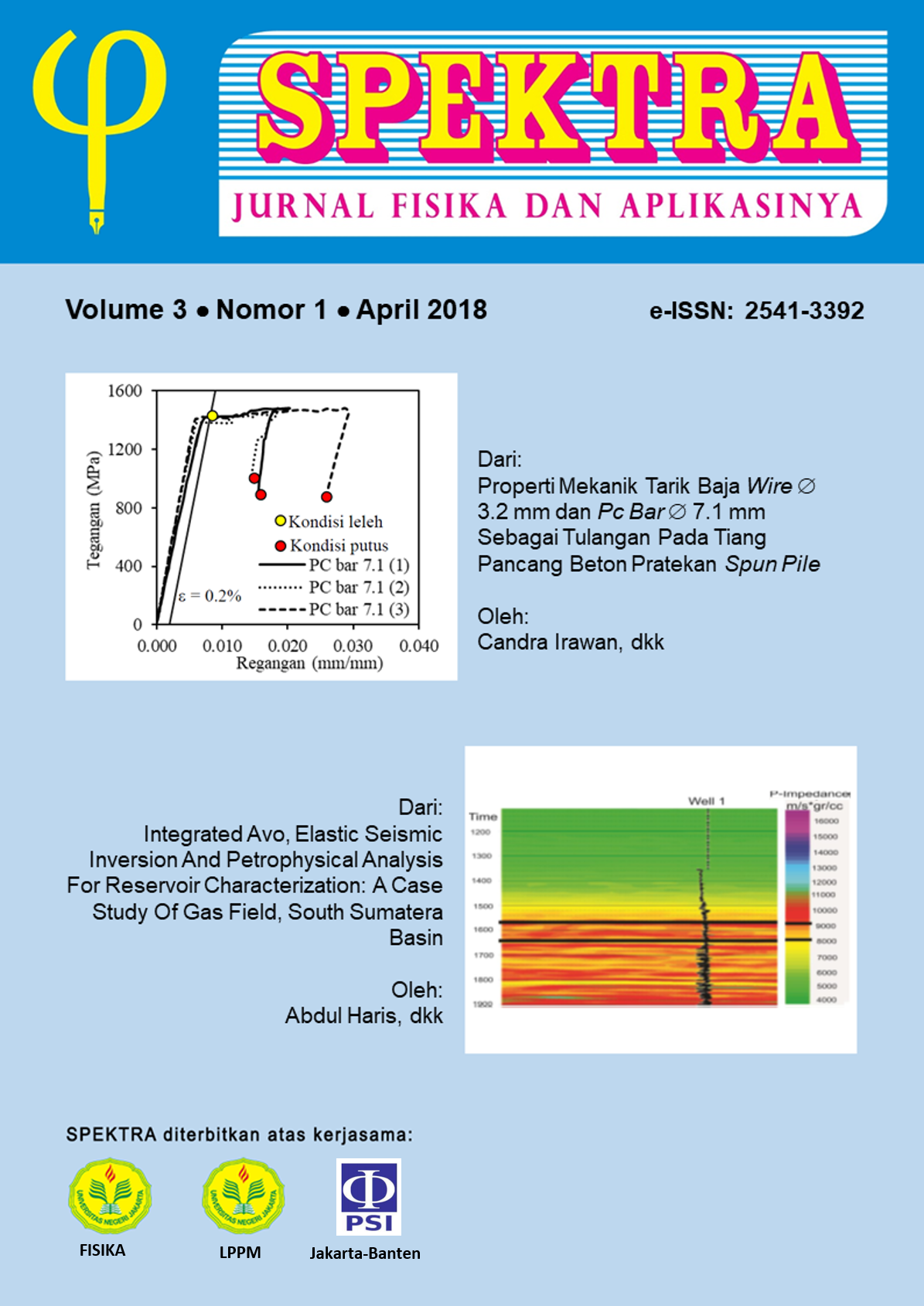INTEGRATED AVO, ELASTIC SEISMIC INVERSION AND PETROPHYSICAL ANALYSIS FOR RESERVOIR CHARACTERIZATION: A CASE STUDY OF GAS FIELD, SOUTH SUMATERA BASIN
DOI:
https://doi.org/10.21009/SPEKTRA.031.02Keywords:
AVO, elastic seismic inversion and petrophysical analysis, south Sumatera basin.Abstract
Integrated Amplitude Versus Offset ( AVO), elastic seismic inversion and petrophysical analysis have been successfully applied to estimate the elastic parameters of the reservoir for a case study of the gas field in south Sumatera basin. This paper aims to have better understanding the petrophysical properties of the reservoir. The petrophysical analysis was carried out by performing routine formation evaluation that includes calculation of shale volume, porosity, and water saturation of basic well log data. Sensitivity analysis was conducted to evaluate the sensitivity parameters of the log for changing in lithology, porosity, and fluid content in the reservoir. For completing the availability of elastic parameter from well log data, shear wave logs were derived from Castagna’s mudrock line relationship. Further, P-impedance, S-impedance, VpVs ratio, LambdaRho (λÏ), MuRho (μÏ) and density(Ï) were then calculated through a Lambda-Mu-Rho (LMR) transformation. Prior to performing AVO analysis and elastic seismic inversion, super gather technique was applied to improve the reliability of pre-stack seismic data. Elastic seismic inversion was carried out to extract the lateral elastic properties to capture lithology and fluid changes in the reservoir. In addition, AVO analysis of pre-stacked data was applied to identify hydrocarbon-bearing sandstone at target zone. The petrophysical analysis shows that porosity versus density crossplot is able to distinguish sand-shale based on 34% shale volume cutoff, while LMR crossplot is able to delineate hydrocarbon zone at water saturation value under 65%. The predicted lateral elastic parameter shows slightly higher value compare to overlying layer.
References
[2] L. A. Gallardo, and M. A. Meju, Joint two-dimensional cross-gradient imaging of magnetotelluric and seismic traveltime data for structural and lithological classification. Geophysical Journal International, (2007). 169(3), pp. 1261-1272.
[3] M. Krief, J. Garat, J. Stellingwerff, and J. Ventre, A petrophysical interpretation using the velocities of P and S waves (full-waveform sonic). The Log Analyst, (1990). 31(06).
[4] G. Y. Yang, and R. R. Stewart. Linking petrophysical parameters (Ï, σ, µ, λ, κ, Ï•) with seismic parameters (α, β, RPP, RPS, RSS). Vol. 7. CREWES Research Report, (Vol. 7, p.1-11), 1997.
[5] D.P. Hampson, B.H. Russell, and B. Bankhead, Simultaneous inversion of pre-stack seismic data. In 2005 SEG Annual Meeting. Society of Exploration Geophysicists (2005, January).
[6] J. P. Castagna, M. L. Batzle, and T. K. Kan. "Rock Physics–The link between rock properties and AVO response, from Offset-dependant reflectivity–theory and practice of AVO analysis, published by the Society of Exploration Geophysicists, edited by Castagna." J, and Backus, M. (1993) p.135 – 171.
[7] J.P. Castagna, and H.W. Swan, Principles of AVO cross-plotting. The leading edge, (1997). 16(4), pp.337-344.
[8] A. Pulunggono, S. A. Haryo, and C. G. Kosuma. "Pre-Tertiary and Tertiary fault systems as a framework of the South Sumatra Basin; a study of SAR-maps." p.339-360, (1992).
[9] M. Risyad, I. N. Suta, and A. Haris. "Fault assessment for basement reservoir compartmentalization: a Case study at Northeast Betara gas field, South Sumatra Basin." AIP Conference Proceedings. Vol. 1862. No. 1. AIP Publishing, (2017).
[10] R.A. Young, and R.D. Lo Piccolo, A comprehensive AVO classification. The Leading Edge, (2003). 22(10), pp.1030-1037.
[11] A.M. Dziewonski, and D.L. Anderson, Preliminary reference Earth model. Physics of the earth and planetary interiors, (1981). 25(4), pp.297-356.
[12] R. A. Young, "A technology to extract lithology, porosity and hydrocarbon content from conventional seismic data." (1999).
[13] R. Bornard, F. Allo, Y. Freudenreich, D.H. Caldwell, and J.G. Hamman, Petrophysical Seismic Inversion to determine more accurate and precise reservoir properties. In SPE Europec/EAGE Annual Conference. Society of Petroleum Engineers (2005, January).
[14] G. H. F. Gardner, L. W. Gardner, and A. R. Gregory, Formation velocity and density—The diagnostic basics for stratigraphic traps. Geophysics, (1974). 39(6), pp.770-780.
[15] A. Haris, Y. Nenggala, S. Suparno, R. Raguwanti, and A. Riyanto, Characterization of low contrast shale-sand reservoir using Poisson impedance inversion: Case study of Gumai formation, Jambas field Jambi Sub-basin. In AIP Conference Proceedings (Vol. 1862, No. 1, p. 030188). AIP Publishing (2017, July).
Downloads
Published
How to Cite
Issue
Section
License
SPEKTRA: Jurnal Fisika dan Aplikasinya allow the author(s) to hold the copyright without restrictions and allow the author(s) to retain publishing rights without restrictions. SPEKTRA: Jurnal Fisika dan Aplikasinya CC-BY or an equivalent license as the optimal license for the publication, distribution, use, and reuse of scholarly work. In developing strategy and setting priorities, SPEKTRA: Jurnal Fisika dan Aplikasinya recognize that free access is better than priced access, libre access is better than free access, and libre under CC-BY or the equivalent is better than libre under more restrictive open licenses. We should achieve what we can when we can. We should not delay achieving free in order to achieve libre, and we should not stop with free when we can achieve libre.
 SPEKTRA: Jurnal Fisika dan Aplikasinya is licensed under a Creative Commons Attribution 4.0 International License.
SPEKTRA: Jurnal Fisika dan Aplikasinya is licensed under a Creative Commons Attribution 4.0 International License.
You are free to:
Share - copy and redistribute the material in any medium or format
Adapt - remix, transform, and build upon the material for any purpose, even commercially.
The licensor cannot revoke these freedoms as long as you follow the license terms.

 E-ISSN 2541-3392
E-ISSN 2541-3392  Focus & Scope
Focus & Scope  Editorial Team
Editorial Team  Reviewer Team
Reviewer Team  Author Guidelines
Author Guidelines  Article Template
Article Template  Author Fee
Author Fee  Publication Ethics
Publication Ethics  Plagiarism Policy
Plagiarism Policy  Open Access Policy
Open Access Policy  Peer Review Process
Peer Review Process  Retraction & Correction
Retraction & Correction  Licensing & Copyright
Licensing & Copyright  Archiving & Repository
Archiving & Repository  Contact
Contact  Mendeley
Mendeley 

